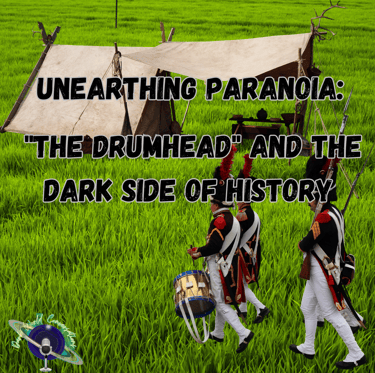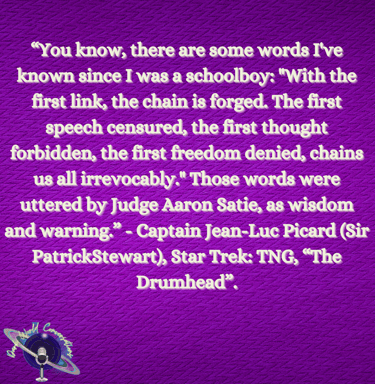
Unearthing Paranoia: "The Drumhead" and the Dark Side of History
Accompany article to the Dark World Conversations podcast episode title Unearthing Paranoia. Compares the Star Trek The Next Generation episode "The Drumhead" in historical context to the Salem Witch Trials and The Red Scare.
ARTS & ENTERTAINMENTCOMMUNITY AND SOCIETYHISTORY


The Drumhead
As always – spoilers a head! As we said in one of our previous articles one of our favorite shows is Star Trek in it’s many incarnations. This week in our podcast we discussed the paranoia that embroiled the trial taking place in the Star Trek: The Next Generation episode titled, “The Drumhead”. This episode masterfully displays how disturbingly easy it is to get engulfed in paranoia and mass hysteria, which should serve as an eloquent reason to be ever vigilant and attentive to these types of scenarios which have often played out in humanity’s past and even in the present.
Before we get into the episode, let’s give a bit of background on the term “Drumhead trial” from a historic point of view. In a historical context, a "Drumhead trial" refers to a type of military trial used during times of war or conflict, typically these trials were characterized by the swift and summary nature action was taken. The term originated from the practice of using a drumhead, or a drumhead gathering, as an impromptu improvised courtroom. These trials were usually held on the actual battlefield or in the temporary military encampments. No official courtrooms in sight.
These types of trials were known for their expedited processing -- bypassing formal legal procedures and the accused’s due process rights; aiming to swiftly and decisively address alleged offenses committed by military personnel, such as insubordination, desertion, cowardice, or acts that were perceived as endangering the military unit's cohesion or safety. The proceedings were often presided over by a commanding officer or a military tribunal, who would act as both judge and jury.
Star Trek TNG: The Drumhead
"The Drumhead" is a powerful episode from Star Trek: The Next Generation that delves into themes of justice, paranoia, and the erosion of civil liberties. This season fourth episode starts off with a spy caught aboard the Enterprise, shortly thereafter there is an equipment malfunction aboard the ship that is then assumed to be a work of sabotage performed by an accomplice of the spy that had been caught. The episode centers around a trial conducted by Admiral Norah Satie aboard the Enterprise-D. The trial begins as an investigation into the possible act of sabotage but quickly spirals out of control into a witch hunt, reminiscent of the Salem witch trials and the "Red Scare" of the 1950s in America.
As the trial advances, Satie becomes increasingly obsessed with uncovering a conspiracy, targeting not only the accused but also anyone who may have even the slightest association with the accused, such as Simon Tariss – who simply treated the accused in sickbay. Captain Jean-Luc Picard, played by Patrick Stewart, rightfully wary of the trial's disturbing direction and took a stand as the voice of reason. He challenged Satie on the erosion of rights and the dangers of allowing paranoia to guide justice.
"The Drumhead" served as a cautionary tale both when it was originally released and even now; this story highlights the dangers of sacrificing individual freedoms in the pursuit of security and the utmost importance of upholding the guiding principles of justice and due process.


The Haunting Terror of the Salem Witch Trials
The Salem witch trials were a series of hearings and persecutions that took place in colonial Massachusetts between 1692 and 1693. The trials resulted in the execution of twenty people, mostly women, who had been accused of witchcraft.
The key causes of the Salem witch trials can be traced back to a combination of religious, social, and economic factors. The strict Puritan religious beliefs and practices of the time fostered a climate of fear and suspicion. The belief in the existence of witches was deeply ingrained in their worldview.
The increasing atmosphere of paranoia of the trials was first caused by the initial accusations that were made by young girls who displayed strange behavior and claimed to be possessed by witches. Their accusations sparked widespread fear and panic in the community. The second cause is that the legal system in Salem of the time allowed for so-called “spectral evidence”, which was based on dreams, visions, and supernatural experiences, to be admitted in court. This opened the floodgates for an onslaught of imagined and trumped up accusations.
Additionally, social tensions, personal vendettas, and economic rivalries fueled the witch hunt. As the accusations spread, the trials became a means of settling scores and advancing personal interests. The community became ensnared by a climate of suspicion and paranoia, which lead to numerous false accusations and the rapid escalation of the trials – we also see this same climate of suspicion and paranoia grip the Enterprise-D in the episode “The Drumhead”.
Ultimately, the Salem witch trials serve as a haunting reminder of the dangers of mass hysteria, the fragility of justice in times of fear, and the devastating consequences of unchecked paranoia and prejudice.
The Red Scare and Persecution
The “Drumhead” episode, while the paranoia has similarities with the Salem Witch Trials, bears a much closer resembles to The Red Scare. The Red Scare of the 1950s, also known as McCarthyism, refers to a period of intense anti-communist sentiment and political repression in the United States, intensely fueled by the fear of communist espionage and even infiltration.
The causes of the Red Scare can be traced back to the geopolitical tensions of the Cold War between the United States and the Soviet Union. The Soviet Union's acquisition of nuclear weapons and the resulting spread of communism in Eastern Europe heightened fears of communist influence and subversion within the society of the United States of the time.
The paranoia surrounding communism escalated with the actions of Senator Joseph McCarthy. McCarthy claimed to possess a list of individuals within the United States government who were allegedly members of the Communist Party or sympathetic to communism. Through hearings (aired on television) and public speeches, McCarthy accused numerous people of being "communist sympathizers" and destroyed many careers in the process.
The escalation of paranoia during the Red Scare was fueled by McCarthy's tactics, including unsubstantiated accusations and guilt by association; he created an environment of fear and suspicion. The House Un-American Activities Committee (HUAC) conducted investigations and interrogations, targeting individuals in the entertainment industry of Hollywood suspected of communist ties. The Hollywood blacklist was established, effectively destroying the careers of many alleged communists or suspected sympathizers.
The media of the time also played a role in fueling the paranoia, as newspapers and newsreels issued sensationalized stories about communist infiltration. The fear of communist influence permeated society, leading to a climate of distrust, surveillance, and self-censorship.
The Red Scare and McCarthyism serve as a dark chapter in American history, characterized by the erosion of civil liberties, the stifling of dissent, and the devastating impact on the lives and careers of many innocent individuals. The era highlights the dangers of unchecked paranoia, the power of fear-mongering, and the importance of upholding democratic values even in times of perceived threats.
Lessons for Today's Society
"The Drumhead" gives a powerful message about how quickly paranoia can spread and the lasting effects it can have on society as historically demonstrated by both the Salem Witch Trials and the Red Scare. This is especially important to remember now as the extreme right of our current political spectrum releases disinformation, spreading fear and prejudice amongst their base to be used against innocents in order to spread their own agenda and further their own careers. They ban books, spread fear, paint targets on the backs of innocent people in the name of getting rid of “wokeness”; yet they can’t even define what that means. So far, apparently, it means being at the very least a decent human being. The consequences of looking away because you don’t know anyone in the communities that they are attacking have the potential to be devastating to the world with the possibility of pushing us back into the dark ages that we thought centuries past. This episode serves as a stark reminder that when we turn a blind eye to the struggles of our fellow human beings, we risk descending into a world of paranoia and fear.
This gripping Star Trek episode compels us to reevaluate our response to suspicion and how we should respond to fear with a rational mind. To us, "The Drumhead" is an episode that surpasses the regular episodes of Star Trek and masterfully paints a vivid reminder of why we should always be vigilant against fear mongers that seek to create mass hysteria and the dangerous consequences of falling for such tactics.
While "Star Trek: The Next Generation" is a work of science fiction, it presents us with a poignant reminders and historical facts that if we are not cognizant of the world around us and if we are not ever vigilant our rights may be taken from us. While any direct correlation must be viewed with caution, exploring these possibilities allows us to reflect and defend against us a possible future.
Disclaimer: It is important to note that the comparison between the Star Trek: The Next Generation episode "The Drumhead”, The Salem Witch Trials, The Red Scare, and the current state of the world is purely subjective and the opinion of the authors.
Links/resources
https://fanlore.org/wiki/Star_Trek:_The_Next_Generation
IMDb Star Trek: TNG “The Drumhead”
https://www.imdb.com/title/tt0708793/
https://military-history.fandom.com/wiki/Drumhead_court-martial
https://en.wikipedia.org/wiki/Red_Scare
Encyclopedia Britannica – Salem Witch Trials
https://www.britannica.com/event/Salem-witch-trials
